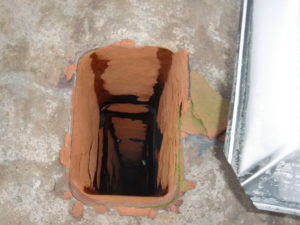Chimney liners are quite the topic of conversation lately it seems. So today I’m going to go over the three primary types of chimney liners, and pros and cons for each. Are you aware that there are three primary types; clay tiles, metal, and cast-in-place? Which is the best to use? What are the differences between the three? Which type of chimney liner is more cost effective? Let’s explore those options.
Clay Tile Chimney Liner
Pros: Inexpensive, readily available, good performance for properly maintained fireplaces
Cons: Do not rapidly absorb and evenly redistribute heat during the rapid temperature rise that occurs during a chimney fire. This uneven heating and cooling may cause the tiles to crack or break. The tiles also cannot adequately absorb the liquid combustion byproducts produced by gas fireplaces or stoves.
To give you a visual on how the clay tile chimney liner can bust, consider what happens when you place a cold drinking glass in very very hot water. The glass instantly shatters. Broken pieces must be repaired before the fireplace is used again.
Metal Chimney Liner
Pros: UL tested and listed, safe, durable, usually stainless steel or aluminum. Stainless steel is best for wood, gas, or oil burning appliances, while aluminum is an inexpensive alternative for gas appliances.
Cons: Aluminum is only an acceptable alternative to stainless steel for certain medium efficiency gas appliances. High temperature insulation may be required with the use of metal chimney liners, increasing the cost.
Cast-in-Place Chimney Liner
Pros: May strengthen weakened chimney structures. Permanent liner, suitable for all types of fuel.
Cons: Permanent liner. If it becomes compromised, you will likely need to replace the entire chimney structure.
Choosing the Right Chimney Liner for Your Needs
This list of pros and cons isn’t an absolute science. It’s meant to be used as a quick guide just to get you started on your more detailed research. Please feel free to call me to discuss the different types of chimney liner. I would love to schedule an appointment with you to properly diagnose your ailing chimney’s needs and make recommendations based on my findings.
Old, unlined chimneys are a hazard to your home and to the safety of your household. If you live in a house build in the 1940s or earlier, call me for a consultation. You may have an unlined chimney that needs serious attention before your next fire. Just because you have an old chimney doesn’t mean it has to be rebuilt; maybe just lined to ensure that it is a properly working component of your home heating system.
Remember, schedule a chimney and flue inspection at least once per year. Many people schedule on important dates such as their anniversary, Father’s Day, Mother’s Day, or another memorable day. I recommend a summertime chimney inspection because that’s the time you aren’t actively using the fireplace, and it gives you a few months to make repairs if needed.

